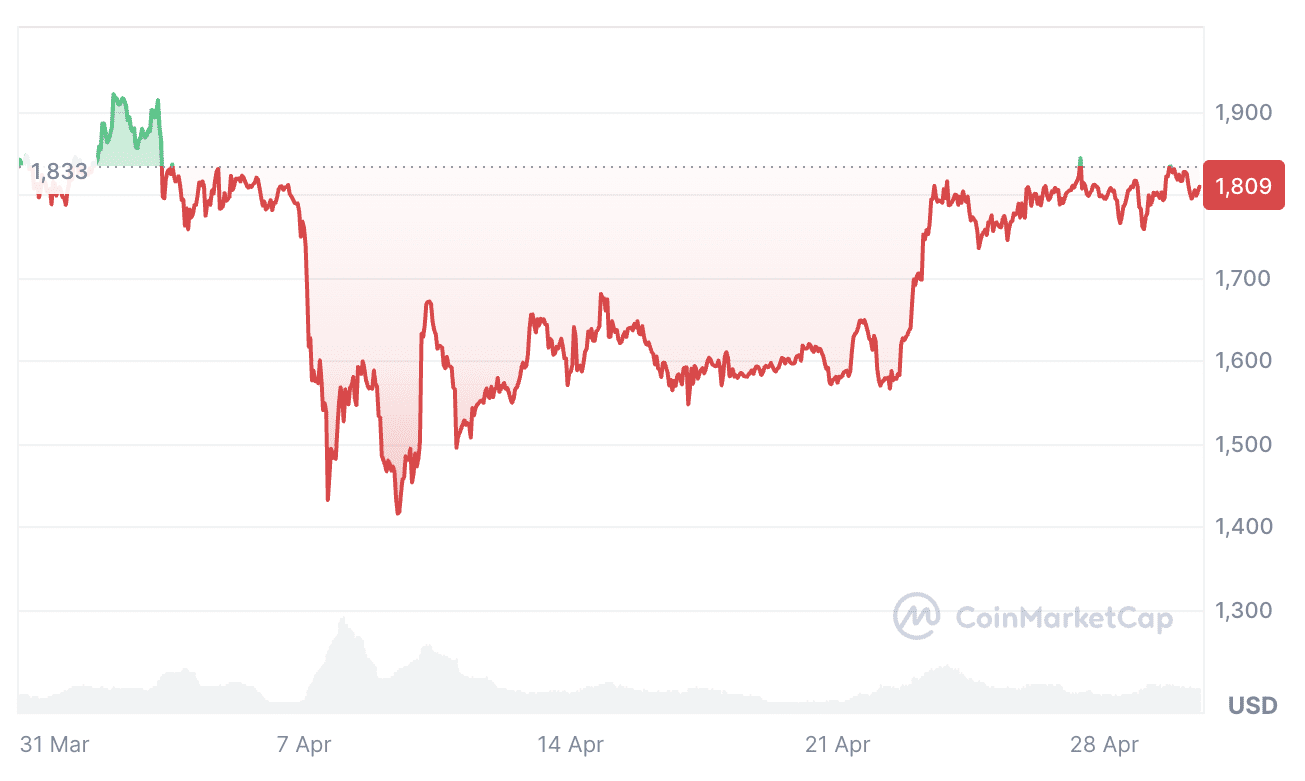Key Takeaways:
- Approval of staking for spot Ether ETFs in the U.S. might have a limited effect on inflows without a multi-month Ether rally, according to Eric Balchunas.
- Ether’s price declined after the ETF launch last year, contrasting with Bitcoin ETFs, which reached new highs shortly after their introduction.
- Balchunas emphasizes the need for a sustained rally and a strong narrative to attract increased inflows into Ether ETFs.
The ability to stake a portion of the tokens held by spot Ethereum ETFs may not be sufficient to drive substantial inflows unless the price of Ether demonstrates a more consistent upward trend, according to Bloomberg ETF analyst Eric Balchunas.
In an April 29 episode of the New Era Finance Podcast, Balchunas stated that the approval of staking for Ether (ETH) ETFs would have a minimal impact on inflows, noting that it could only be beneficial.
Price Rally as a Catalyst for ETF Success
Balchunas pointed out that the primary reason for the underwhelming inflows into Ether ETFs since their launch in July is the absence of a sustained rally in ETH’s price.
“The bigger problem with Ethereum is performance; it just doesn’t ever go on a nice long rally.”
He observed a direct correlation between Ether’s price surge during a rally in December and a corresponding increase in inflows.
The crypto market rally triggered by Donald Trump’s election victory in November led to a 71% surge in ETH, reaching $4,107 on December 16.
From November 22, spot Ether ETFs experienced a 19-day positive inflow streak, accumulating approximately $2.44 billion in inflows, data from Farside shows.

However, since reaching the $4,107 price level, Ether has entered a downtrend, falling 56% to trade around $1,809 at the time of publication, according to CoinMarketCap data.
Balchunas stressed that a “multimonth run” coupled with a “strong narrative” is essential for inflows to rebound.
“It needs something that is more than just a good week here and there,” he added.
Balchunas mentioned that the price “went down quickly” after the launch of Ether ETFs, hindering any recovery, unlike spot Bitcoin ETFs, which saw Bitcoin (BTC) reach a new all-time high just two months after their launch in January 2024.
“When you launch an ETF, and you have that sort of performance out of the gate, it’s tough,” he said.
Understanding Ethereum ETFs and Staking:
An Ethereum ETF (Exchange Traded Fund) allows investors to gain exposure to Ethereum without directly owning the cryptocurrency. This simplifies the investment process and makes it accessible to a broader audience.
Staking, in the context of Ethereum, involves locking up a certain amount of ETH to participate in the network’s validation process. Staking helps secure the network and, in return, stakers receive rewards in the form of additional ETH.
The Current Landscape:
The launch of spot Ethereum ETFs was highly anticipated, but their performance has been lackluster compared to Bitcoin ETFs. Several factors contribute to this:
- Price Volatility: Ethereum’s price has been more volatile than Bitcoin’s, making it a riskier investment in the short term.
- Market Sentiment: Market sentiment towards Ethereum has been less bullish than towards Bitcoin.
- Regulatory Uncertainty: The regulatory environment surrounding cryptocurrencies remains uncertain, which can deter institutional investors.
Why a Rally is Crucial:
A sustained price rally can significantly improve market sentiment and attract more investors to Ethereum ETFs. A rally would signal confidence in Ethereum’s long-term potential and demonstrate its ability to generate returns.
The Role of Staking:
The approval of staking for Ethereum ETFs could potentially increase their appeal. Staking rewards could provide an additional source of income for ETF holders, making them more attractive compared to non-staking ETFs.
Potential Hurdles and Future Prospects:
Despite the potential benefits of staking, several hurdles remain:
- Regulatory Approval: The SEC must approve staking for Ethereum ETFs.
- Market Conditions: The overall market conditions for cryptocurrencies need to improve.
- Investor Education: Investors need to be educated about the benefits and risks of Ethereum ETFs and staking.
Broader Implications and Future Outlook:
The success of Ethereum ETFs could pave the way for more cryptocurrency-based investment products and further legitimize the crypto market. A successful Ethereum ETF could attract significant institutional investment, boosting the entire crypto ecosystem. Additionally, the adoption of staking by ETFs could encourage more users to participate in securing the Ethereum network.
In conclusion, While the approval of staking for spot Ether ETFs represents a positive step, a sustained rally in Ether’s price and a compelling market narrative are crucial for driving significant inflows and achieving the success of these ETFs. The future of Ethereum ETFs depends on a combination of regulatory approvals, market conditions, and investor education.
This article does not contain investment advice or recommendations. Every investment and trading move involves risk, and readers should conduct their own research when making a decision.